|
Antissa is one of the best and most interesting of the traditional mountain villages of Lesvos.
Almost completely undeveloped Antissa sits on the side of a
mountain and is the regional center for the
villages of Vatousa, Xidera, Gavatha, Liota, Rema,
Zithra and Pterounda. There is a large and
beautiful platia with not one, but three enormous
platanos trees that make the village a very cool
place to come on a hot afternoon.
|
|
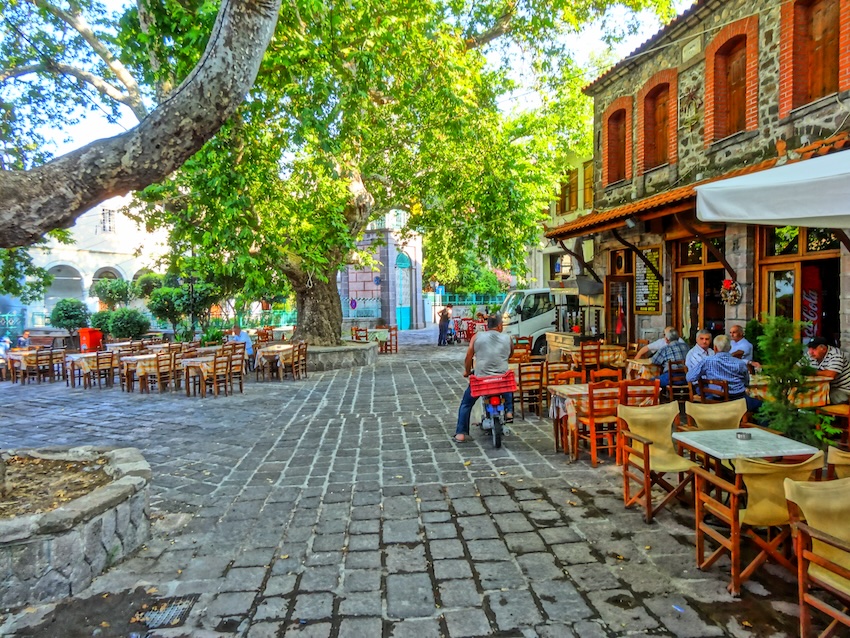
Antissa
|
|
There are
several restaurants and kafeneions in the square There's a pharmacy in the village, something
that none of the other villages in the vicinity
have and a post office. There is also a medical
center which serves as a hospital for this part of
the island. The only drawback to the area is that
there are few if any places to stay besides a few scattered rooms that can be found on Booking.com's Antissa Page or by Contacting Sappho Travel. But if you can't find anything it's anice place to come for a day and especially nice to come for dinner. Even when the rest of the island is hot, the Platia in Antissa is usually comfortable and
there are several very good tavernas here which specialize in local meat, fresh fish and vegetables including the excellent To Kati Allo, known throughout Western Lesvos for his paidaikia and other grilled meats.
|
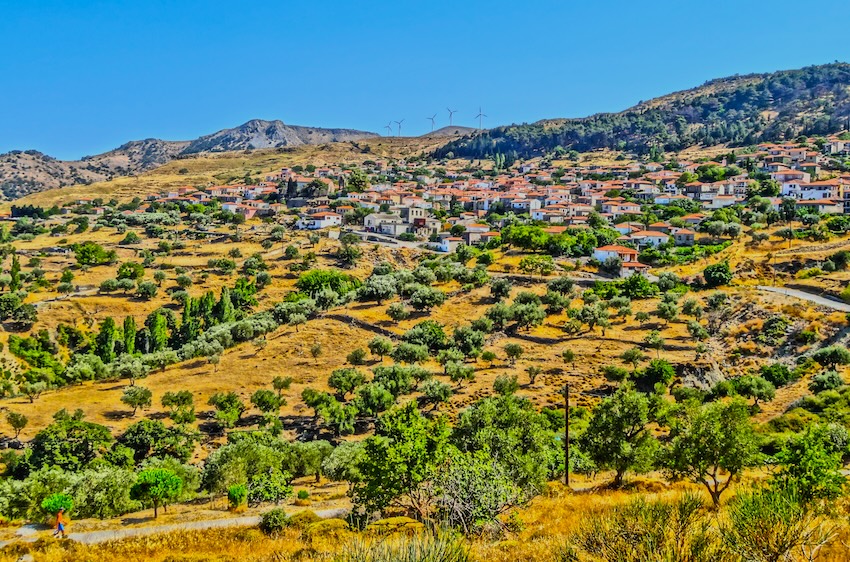 |
|
If you are looking for a good place to buy an affordable house in Lesvos, Antissa is a great place to look because it is big and lively enough to be here year round and though not on the beach it is close enough. You can probably find something inexpensive on the website of SapphoEstate
|
|
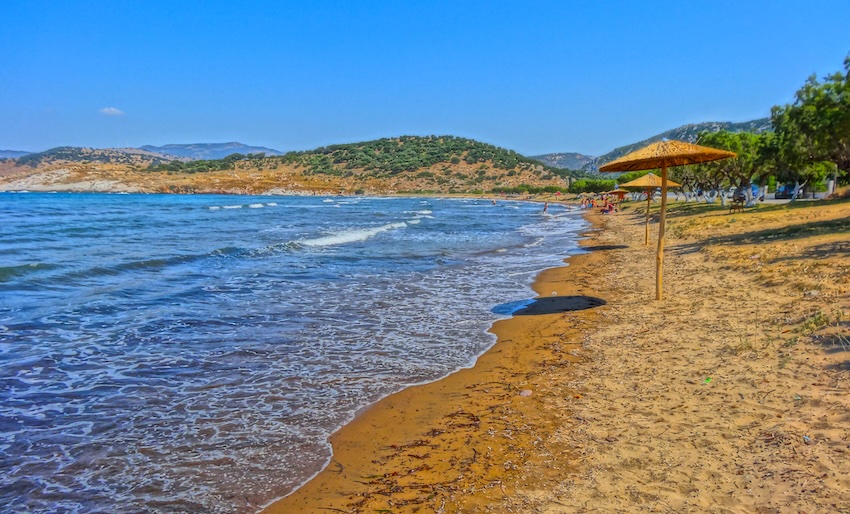
Gavatha
|
|
Below Antissa through a sea of olive trees you come to a small harbor full of fishing
boats and a long beach with a few trees that offer
shade, a beach taverna and a cantina that serves drinks, sandwiches, a few simple dishes and plays a lot of Santana. Gavatha is built upon a peninsula that
shelters the main beach. There is a
small Church of St. Pandelemon on the rocks above
the village.
|
|
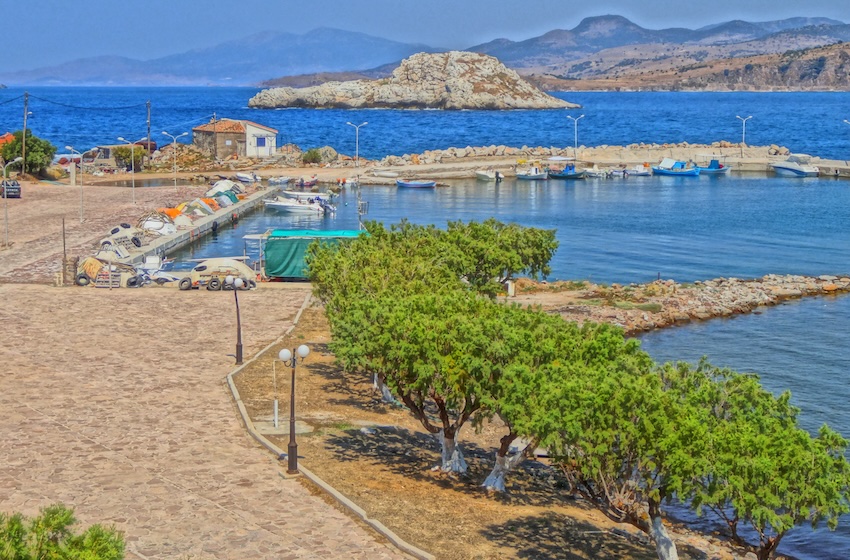
Gavatha
|
|
Most of the
tourists who come here can't be called tourists
any longer because they have been coming for years
and are almost a part of the village. Many have
bought homes in the area. It's a very quiet place
with virtually no nightlife beyond whatever may be
happening at the beach taverna. Most people go up to Antissa which by comparison is cosmopolitan. The Paradise was one of the best
restaurants on the island and people came from all
over to eat and enjoy the view. The owner was an
extremely hard working woman named Stacy, who
moved to the island from New Jersey 25 years
ago.
She closed several years ago and sadly she passed away in 2020. I am sorry she never got to reopen it because it really was a special place. But right next door to Stacy's former restaurant, overlooking the bay, is a small fish taverna called O Rofos which is worth going out of your way for though currently it seems to only be open at night. Also on the beach in Gavatha the Taverna Tsolias which has grilled meat, the usual seasonal fish and oven cooked dishes and if you are coming in the non-summer months the most likely to be open. Free sunbeds and umbrellas if you eat there. This is the restaurant in Gavatha that most of the villagers in this area eat at.
|
|
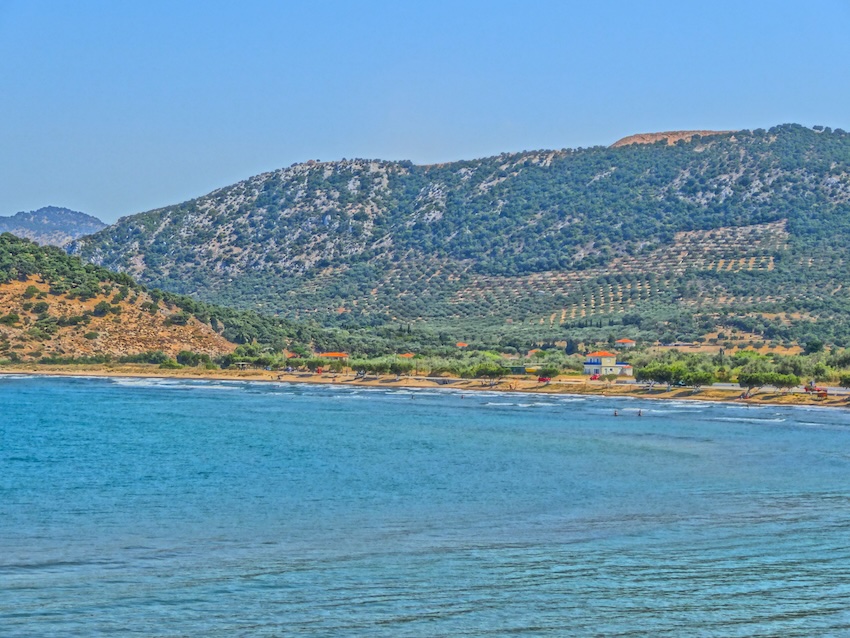
Gavatha
|
|
The beach at Gavatha is a good one for those who like sandy beaches, though when the wind blows from the north there can be waves and flying sand, but it is usually calm the closer you are to the town. There used to be a lot of
seaweed which washed up on the shore but the
villagers made a courageous effort to get rid of it,
perhaps believing it makes the area undesirable to
tourists, and have been pretty successful. But the
truth is that even when there was a lot of
seaweed, once you walk out a few meters the sea is
as clear as anywhere. The best place to swim is
the far end of the beach near the Cantina that serves drinks and food. Snorkling along the
rocks is fine though there are not a lot of fish.
If you snorkle far enough you will come to the
beach at Kampo Antissa. You can also drive there by
following the signs through the valley which is probably a better way to travel.
|
|
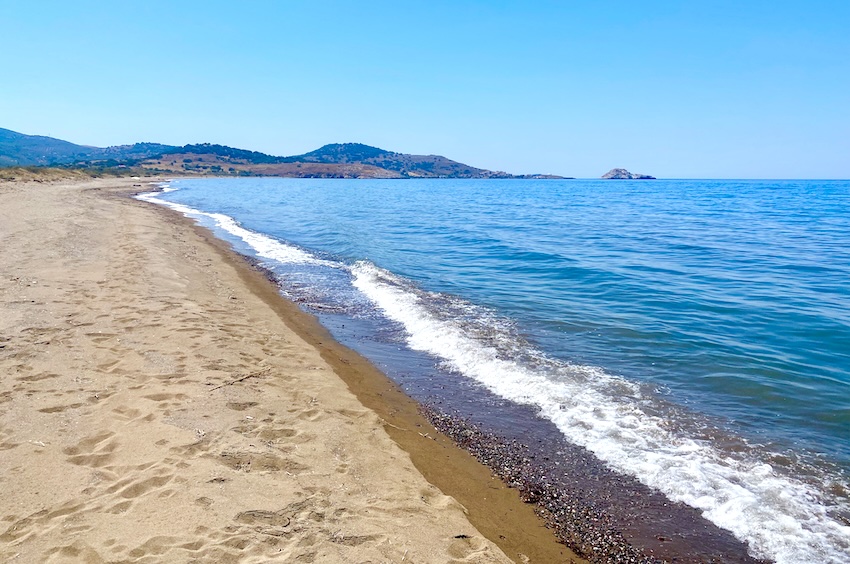
Kampo Antissa
|
|
Kampo Antissa is full of olive trees, orchards, farms and
gardens and the dominant color is green. Campo Antissa has even bigger waves with a strong north wind and if you are not a good swimmer you may want to stay close to shore. But even in the summer the beach can be empty and if you are a practicing nudist looking for privacy or a Deadhead with a satchel full of shrooms then this is the place to go if you want to be left alone. When the wind
comes from the north east there are great waves.
When it blows from the south the sea is calm and
when there is no wind at all it's like a millpond. There are a couple conveniently placed changing cabanas, not that you will need them since there probably won't be anyone here. There are also showers and a covered area with a picnic table. Both ends of the beach are rocky but the middle part is sandy and it is a very long middle part. They say that the head of Orpheus washed ashore here (or Lapsarna-depending on who you ask). There is a path to the Cave of Orpheus where they say his head and Lyre are burried. The cave is reachable on foot though it requires some climbing but it is the most impressive cave on Lesvos and is said to be a magical place. The trail starts on a gravel road below Antissa.
|
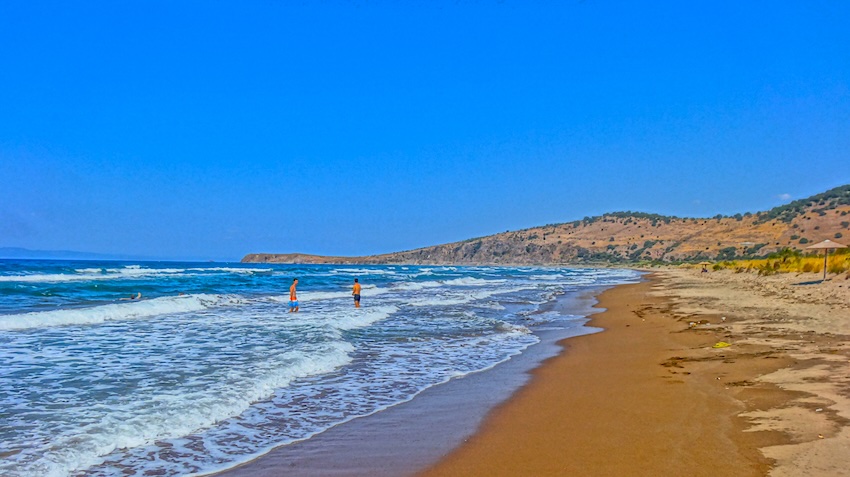 |
|
In Campo Antissa the valley is a collection of farms and
gardens. Directly across the sea Turkey is close
enough to be clearly visible every day. If you
follow the riverbed which has been paved it will
take you past the old Kostas Taverna on the right and down to
the beach. There is a pond at the end that is full
of eels, frogs and turtles and there are lots of
interesting birds around. One you get to the beach
you can choose to drive to your right or walk to
your left where the promontory that seperates
Campo Antissa from the beach of Gavatha begins and
you can have as much privacy as you like.
On the road between Kampo Antissa and Gavatha is a sign to Liota which has one of the oldest platanos trees on the island, a healing spring and the very nice little Taverna Liota that is often busy but well worth going to. The story goes that Princess Ligiri was sent here because she had an incurable disease and saw some pigs with sores on them going into the water that was gushing from the ground and emerging healed. She bathed in the water and became healed as well. The 16th Century Panagia Liotas was built to honor this miracle and the church is still here.
|
|
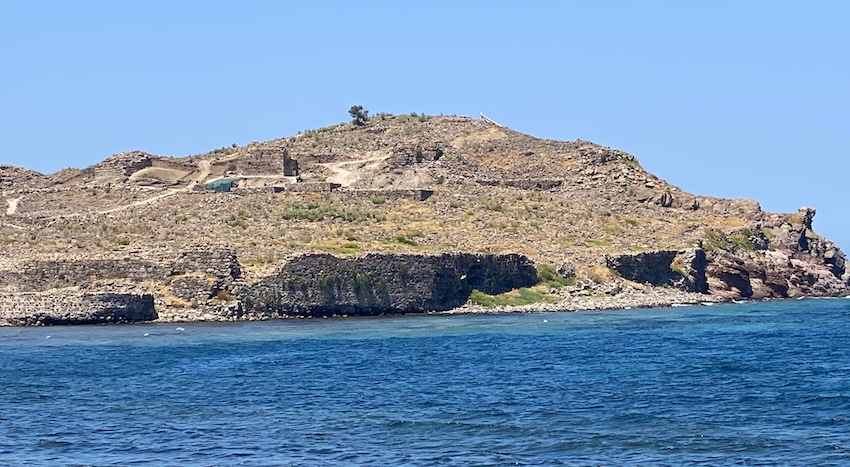
Ancient Antissa
|
|
If you follow
the road east past Campo Antissa you will pass
brilliant green fields of clover and drive
alongside a river. The road crosses the
river and goes through a small settlement
before coming to the ruins of ancient Antissa on a
promontory. It's an interesting area with ancient
stones scattered around and some big walls stillstanding and they recently started an archaeological excavation of this important ancient city. The beach is a wild one, pretty much all stone, often with big waves and whatever debris the waves bring in. It is not great for swimming unless there is no wind and even then you will need watershoes. But there is a path to the sea and a shower right in front of the Taverna Ancient Antissa which is only open in the summer but is one of the best restaurants in the area.
|
|

Agia Barbara Beach
If you continue past the archaeological site there is a
very pretty church, Agia Barbara, that sits above the small shallow sandy beach of the same name. A short walk from there is the Taverna Obriokastro, open in the summer and also very good. (The road is hell on small cars and should
be taken slowly and sober or with a jeep). The road continues on to the beaches below the village of Skalohori.
|
|
|
Antissa and Gavatha Review
So here's a few odds and ends that I may have mentioned above but may not have. Anyway they should make your trip more interesting....
|
|

|
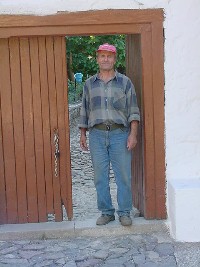
|
|
If you want a very nice traditional experience stop and have a meal or coffee at Kafeneion Aigaio, the last one you come to in the Platia. It is run by a nice old woman and only has a few items but it is a unique place and she is very sweet. |
The
Perivoli Monastery between Antissa
and Vatoussa is a garden paradise.
The caretaker is quite nice with
an ability to speak in rhyme a
good portion of the time. See the Byzantine wall frescos that have recently been restored. |
|
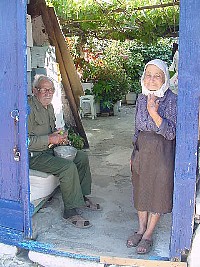
|
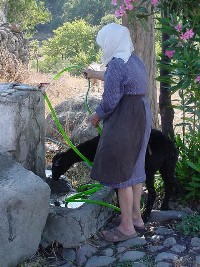
|
|
The
village of Zithra between Antissa
and Vatousa has known better
times. Most of the houses are now
in ruins and this old couple are
two of only a handful of people
still living there. What
will happen to Zithra is anybody's
guess. It may end up being totally
deserted or bought up by
foreigners and there is evidence
of some houses being fixed,
perhaps by relatives.
|
|
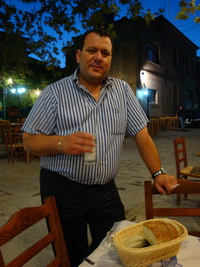
|
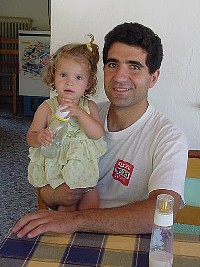 |
|
The
whole island is full of
Greek-Americans and Australians
who have returned to their home to
retire or start new businesses.
Pablos Kalfas is one of
those. The former Eressos taxi driver from Australia has opened To Kati Allo in the tree-shaded square of Antissa and his food is a step above what you will find in most villages. |
Lunch
at Kostas in Campo Antissa was a
tradition but he closed in the winter of 2025 and I hear he is working somewhere in Molyvos. If you see him tell him that we miss him and Campo is not the same without him. Hopefully someone will take over the space but in the meantime there are other restaurants nearby. |
More
about Antissa from In Search of Sardeles Pastes
|















